The World's Biggest Physics Experiment Is About to Reboot
36,517
The Large Hadron Collider (LHC) is the most audacious physics
experiment in human history. Now scientists are about to restart the
giant particle collider for a new set of experiments. Last time, they
did the almost-impossible and found the Higgs Boson. This time, they might find something even more exciting.
Back in 2008,
just nine days into its first run of experiments, there was a
significant incident at the Large Hadron Collider. A faulty electrical
connection between two magnets stopped superconducting, then melted and
caused serious mechanical damage to the facility. The accident delayed
use of the LHC for six whole months as repairs and testing was
undertaken—but it also meant that the facility ran for three years at
much lower capacity than envisioned.
Clearly the collider coped. On July 4th 2012, scientists from two
experiments at the LHC—CMS and ATLAS—announced that they had discovered
a new boson. It was the Higgs Boson;
the invisible particle that gives everything mass and, in turn, holds
the universe together. The finding was arguably the biggest scientific
finding of the decade, perhaps even more.
But all the while it was running below par. The LHC shut down for
maintenance in 2013, though, and over the past two years, engineers have beefed it up. They've upgraded the superconducting interconnections between a series of magnets on the accelerator, adding extra shunts and more powerful magnets.
The shunts provide a route through which current can escape if
high-power accidents—like the one that caused the break back in
2008—happen again, meaning it's safer to run at higher energy levels.
Just 27,000 shunts around the 16.7-mile circumference accelerator
later, the LHC is back in business. And more powerful than ever.
Absolute Power
When the LHC closed down in 2013, its highest energy experiments has
been carried out at 8 teraelectron volts (TeV). Soon, scientists at the
LHC will be able to ratchet the accelerator to an unprecedented 13TeV.
For most of us that's a fairly incomprehensible unit of energy, though,
so LHC scientists have prepared a neat analogy to help those without
degrees in particle physics. The newly refurbished LHC can create beams
of particles that carry energy to melt a tonne of copper on impact.
That's... impressive.
"The higher energy means more chance of finding new discoveries,"
explains Alan Barr, a Professor of Particle Physics at the University of
Oxford who works on the ATLAS experiment at the Large Hadron Collider.
"The LHC's higher energy can give us sensitivity to new,
as-yet-undiscovered particles."
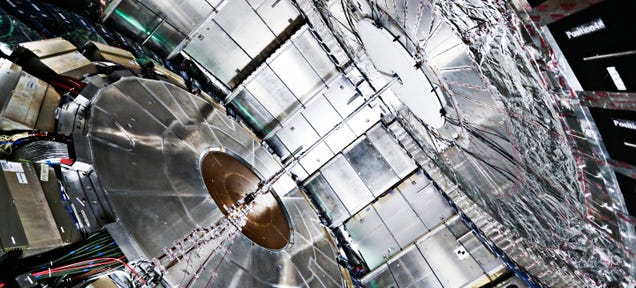
Einstein's famed equation, E=mc2, explains that that energy
and mass are broadly equivalent, so in practice extra energy allows the
scientists to find heavier particles than before. "The kinetic energy
of the colliding particles is converted into the mass of heavier
particles, which immediately decay back into the particles with which we
are familiar," explains James Hirschauer from the Fermi National
Accelerator Laboratory who works on experiments at the LHC. "We are
hoping that we will produce heavier particles that are so far unknown —
just like we produced and discovered the Higgs boson in 2012. The energy
jump is desirable because, if a new heavy particle exists, the rate of
production of that particle will be higher at higher collision
energies." In an email, Hirschauer gave me a great example of why
increasing the rate of particle production is so important:
"We now know that we were producing Higgs bosons at the Fermilab Tevatron (collision energy of 1.96TeV). But there were relatively few Higgs bosons, and they were hidden by the enormous "background" of non-Higgs collisions at the Tevatron, so we could not separate the Higgs signal from the background in our analyses of the Tevatron data. However, at the higher energy of the 8TeV LHC, each collision was about 30 times more likely to produce a Higgs boson than at the 2TeV Tevatron. So in a given number of collisions, we produced about 30 times more Higgs bosons at the LHC than at the Tevatron. [I]n case you are wondering: People often ask, doesn't the *background* production rate also increase with increasing collision energy? Indeed the background rate does increase, but not as much as the production rate for a high mass particle, so we still gain by moving to higher collision energy."
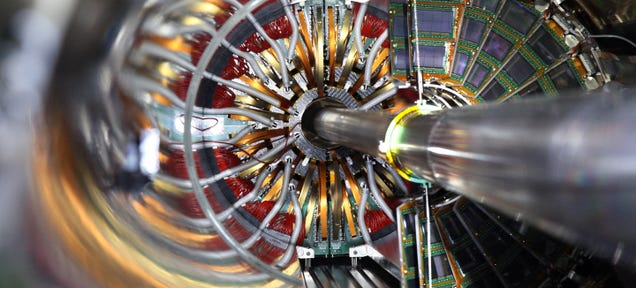
Sadly, it's not possible to simply flick a switch on the LHC and summon
13TeV on demand. Instead, the $6 billion accelerator requires a gradual
warm up before it reaches peak power. Last week, CERN researchers sent
the first test particles through the accelerator. Slowly, over the
coming weeks, they'll send more and more, each time checking the
alignment of the beams and the accelerator's ability handle them. Cern's
director general, Rolf-Dieter Heuer, has said that the LHC will be
loaded with the first proper proton beams in the next two weeks. The
accelerator should gradually ramp up to higher energies, with the
resulting collisions—which will be the most energetic ever created by
humans—due to follow near the end of May.
Dark Secrets
The results may not initially seem worth the wait. When the new
high-energy collisions begin, we'll initially see more of the same.
After all, we managed to glimpse the Higgs at 8 TeV so, as Hirschauer's
reasoning tells us, in the first instance we'll just see even more of
them at these higher energies. That might not be too exciting, but it
will help us understand the relatively new particle more precisely,
enabling more accurate measurements of its properties.
But there will likely be more. "One thing we think we might discover
are supersymmetric particles," explains Hirschauer. Super symmetrical
particles are the theoretical partners of each of the particles
explained by the Standard Model—the most elementary particles that we
know of, like quarks, leptons and bosons. While the Standard Model does a
wonderful job of explaining particle physicists, scientists admit that
it's incomplete.
Taken at face value, the Standard Model predicts that all particles
should have zero mass—but that disagrees with direct human observation
of the world around us. While the Higgs boson goes some way to
explaining why other particles have mass, it remains a mystery why it
itself also has no mass. An additional set of supersymmetric particles
that behave similar properties but have different masses, physicists
suggest, could cancel out contributions to the Higgs mass from their
Standard-Model partners—making a massless Higgs boson possible. In turn,
that would make it possible to mathematically link the Standard Model's
three forces – electromagnetism and the strong and weak nuclear forces –
and create single unified theory to explain the Universe. A theory of
everything.
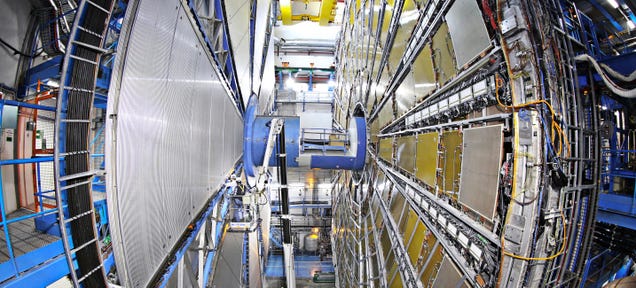
"For certain supersymmetric particles, the production rate increases by
a factor of about 30 when we increase the collision energy from 8TeV to
13TeV," explains Hirschauer. "At the same time, the production rate for
the main 'background' to this supersymmetric 'signal' only increases by
a factor of about 4. So the signal-to-background ratio will increase by
a factor of about 7.5. This is a huge and very exciting gain!" In other
words, the LHC is currently the best chance we have of creating a
unified theory.
Those supersymmetric particles might not just help us to develop a
powerful equation though. They could also explain one of the most
enigmatic theories in physics: Dark Matter. "Most of the universe is
made of Dark Matter," explains Barr. "That is stuff that pulls
gravitationally on matter around it, but which doesn't interact with
light, so is invisible. But it's very hard to detect." Dark matter
theoretically accounts for up 80 per cent of the mass of the
universe—but we've never yet observed a particle with the qualities we
think it should exhibit. Perhaps unsurprisingly, then, scientists around
the world are hopeful that the new experiments at the LHC might reveal
something "It would be truly ground-breaking if we could find, in the
debris from the LHC collisions, evidence for the particle (or particles)
which are responsible for this Dark Matter," enthuses Barr. "We know
they're not made of any particle we have already found, so the terra incognita that will be explored by the LHC is really very exciting."
Perhaps
most tantalisingly, if one school of physics thinking is to be believed,
we could potentially hit the jackpot and find both at once. "Based on
our theories and the indirect evidence, these dark matter particles
[could be] the same supersymmetric particles," explains Hirschauer. "I
am personally working hard to discover dark matter particles under the
assumption that they are supersymmetric particles."
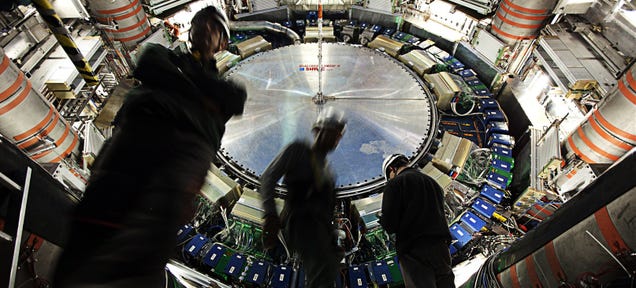
All of this is, of course, far from certain. The nature of
experimentation is that, however good your theories seem, reality can
turn out to be something entirely unexpected. That, though, could end up
being the most exciting outcome we could hope for. "On my most wildly
optimistic day, [I imagine] we will discover something—anything—that
disagrees with our current understanding of the universe," explains
Hirschauer. "Disagreement will show us how we need to refine our
theories to correctly explain the laws of nature. I promise that we will
not be disappointed if we instead discover something completely
unanticipated!"
All images by CERN
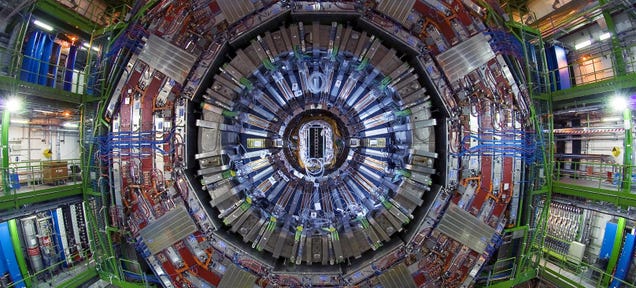
No comments:
Post a Comment